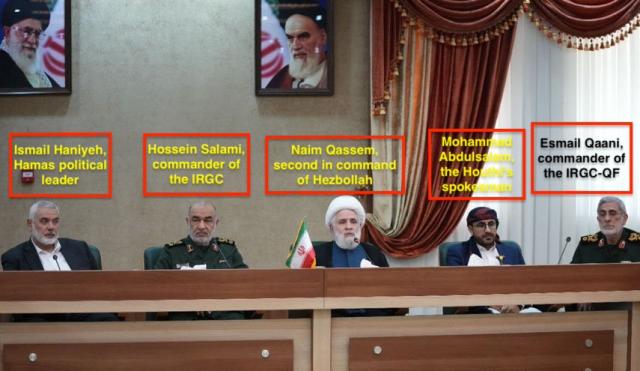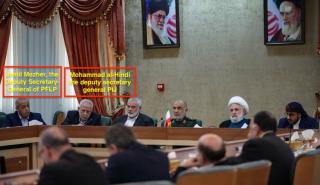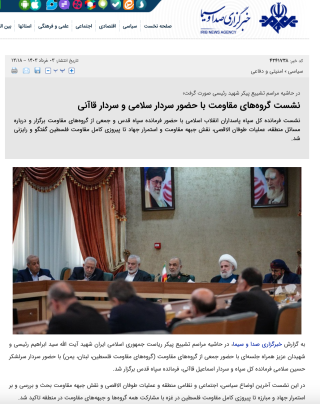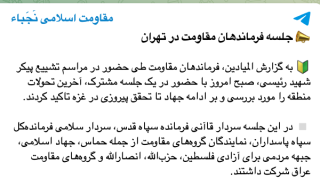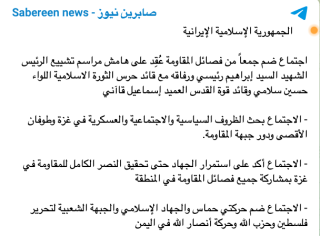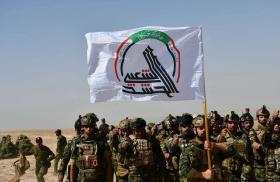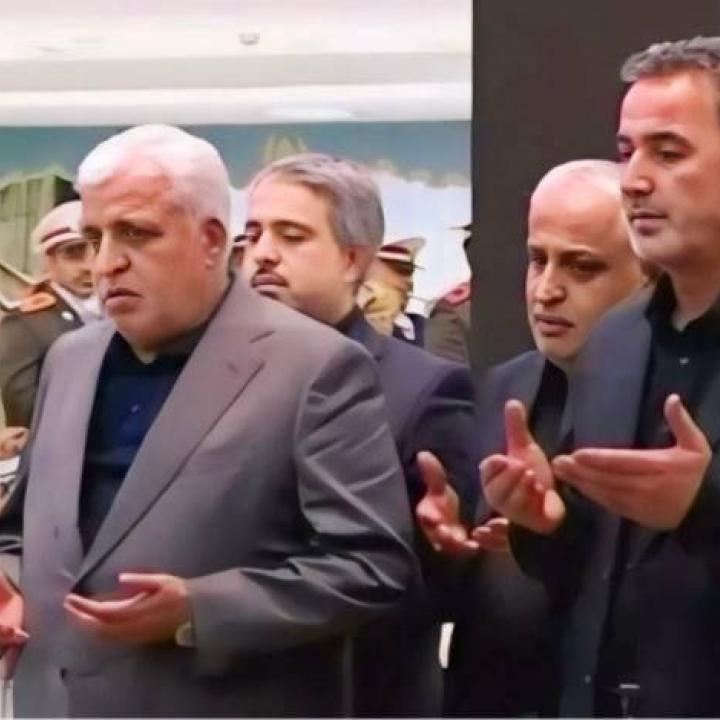
The PMF Represents Iraq at the Axis of Resistance Conference in Tehran

Iraqi militias were nowhere to be seen at the Tehran conference, but an IRGC outlet described the PMF as appearing alongside Hezbollah, Hamas, the Houthis, and other U.S.-designated terrorist groups.
On May 23, Maj. Gen. Hossein Salami, commander-in-chief of Iran's Islamic Revolutionary Guard Corps (IRGC), and Brig. Gen. Esmail Qaani, commander of the IRGC-Qods Force, met with leaders of the so-called "axis of resistance" who were present in Tehran for the funeral of President Ebrahim Raisi. Only two still photos were published from the meeting (Figures 1 and 2), analysis of which makes clear that Iraqi muqawama (resistance) groups did not get a seat at the "top" table with Salami (center) and Qaani (to the side). The only terrorist groups present at that table were Hamas (represented by Ismail Haniyeh), Lebanese Hezbollah (second-in-command Naim Qassem), the Houthis (spokesman Mohammed Abdulsalam), Palestinian Islamic Jihad (PIJ) (deputy secretary-general Mohammed al-Hindi), and the Popular Front for the Liberation of Palestine (PFLP) (deputy secretary-general Jamil Mezher).
Interestingly, no figure from the Iraqi muqawama is shown in either photo. In other words, the IRGC lionized a non-Islamic, socialist militia—the PFLP—in publicizing the meeting but not any of its Iraqi proxies. It is unclear whether senior Iraqi militants were present but not pictured (some were in Tehran at the time but may or may not have attended the meeting; others reportedly visited the Iranian embassy in Iraq instead); alternatively, they may be planning to visit Tehran separately as a group to express their condolences. Whatever the case, it was unusual to see such status-conscious groups miss an opportunity to be seen as top-level actors in the "axis."
Most Iranian outlets reporting on the event mentioned all other militias except for Iraqi groups. For example, Islamic Republic of Iran Broadcasting (IRIB) noted, “A meeting was held between a group of muqawama groups (Palestinian, Lebanese, and Yemeni muqawama groups) and Major General Hossein Salami...and General Esmail Qaani,” with no mention of an Iraqi presence (Figure 3).
IRGC Says Iraq’s PMF Are Part of Its Resistance Axis
Fars News Agency, widely considered an IRGC mouthpiece, was the only Iranian outlet to mention Iraqi participation at the conference. It described the Iraqi delegation as being from the “Popular Mobilization Forces" (PMF), then later changed the phrasing to "Iraqi muqawama groups"—but not before the BBC had translated the original uncorrected text. This was a significant slip: the IRGC essentially claimed that the Iraqi state-run PMF were a "resistance" faction comparable to the gaggle of U.S.-designated terrorist groups represented in the pictures above.
On April 5, PMF Chief of Staff Abdal-Aziz al-Mohammadawi (aka Abu Fadak) stated, “The PMF is a fundamental part of the battle in Gaza and Palestine.” At the time, he was in Tehran to participate in a Qods Day march. He and PMF chairman Faleh al-Fayyad visited Tehran again to take part in the mourning ceremonies for Raisi, so they may have been present at the May 23 conference as well—if so, they were careful to stay off-camera.
Abu Fadak has been increasingly willing to publicly link the PMF—through his person—to the "axis of resistance." On April 5, he seemed to speak out of embarrassment when standing alongside a PIJ leader whose forces were actively engaged in the Gaza war, emphasizing his desire to contribute to the “resistance” cause. He even openly admitted to taking orders primarily from a foreign official, Iran's Supreme Leader Ali Khamenei, stating: "We are waiting for the [Supreme] Leader to express his view on the next step...We came to the Islamic Republic first to express our solidarity with the vision and plan of the Leader and the Imam...and second to renew our covenant [i.e., loyalty to the Supreme Leader] and wait for the Leader’s decision.”
Individual Militias Excluded, Embarrassed, or Cautious?
As mentioned above, the Iraqi muqawama might be waiting to go to Tehran together, as they mostly did after Qasem Soleimani’s death in 2020. This seems to be the IRGC's way of minimizing rivalries and making such meetings more manageable. In 2020, however, the militias made their group visit immediately after Soleimani's death, accompanied by Muqtada al-Sadr—this time, no such group has been reported openly attending key funeral ceremonies for Raisi or the "resistance" conference.
The Farsi Telegram account run by the militia Harakat Hezbollah al-Nujaba claimed that “representatives of...Iraqi muqawama groups” were present at the conference (Figure 4). Even if this report is true, however, their presence was so insignificant that it was barely mentioned by the media, while the IRGC did not bother to release photos showing them. This seems to have embarrassed Iraqi muqawama media to the point that they did not heavily report on the conference, despite wide coverage of the event by numerous international media outlets such as Al-Jazeera, CNN Arabic, Asharq al-Awsat, and the Times of Israel.
Sabereen News, the main Iraqi muqawama social media channel on Telegram, was apparently so embarrassed that it did not mention the presence of Iraqi militia officials at the conference (Figure 5). The outlet is always very quick to post photos of similar meetings in order to boast about its access, yet it refrained from posting the photos published by the IRGC.

